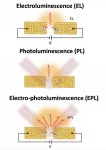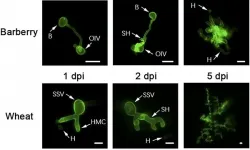(Press-News.org) For the first time, scientists have documented biofluorescence in an Arctic fish species. The study, led by researchers at the American Museum of Natural History who spent hours in the icy waters off of Greenland where the red-and-green-glowing snailfish was found, is published today in the American Museum Novitates.
"Overall, we found marine fluorescence to be quite rare in the Arctic, in both invertebrate and vertebrate lineages," said John Sparks, a curator in the American Museum of Natural History's Department of Ichthyology and one of the authors of the study. "So we were surprised to find these juvenile snailfish brightly fluorescing in not just one, but two different colors, which is very unusual in a single species."
In 2014, Sparks and colleague David Gruber, a research associate at the Museum and a biology professor at Baruch College, identified more than 180 new species of fishes that biofluoresce, the ability to convert blue wavelengths into green, red, or yellow light. This ability, which could be used for behaviors including communication and mating in some species, is now well documented in tropical fishes that live in regions where there is an even amount of daylight year-round. But in the Arctic, where days can be incredibly long or incredibly short, researchers were interested in seeing firsthand how prolonged periods of darkness affected fishes' ability to biofluoresce.
"The light regime at the poles provides for winter months of near total darkness, where biofluorescence would not be functional," Gruber said. "But given the summer months with the midnight Sun, we hypothesized that it could be present."
In 2019, as part of a Constantine. S. Niarchos Expedition, Sparks and Gruber headed to the iceberg habitats off the coast of Eastern Greenland to test their theory. In addition to finding very little marine fluorescence, they observed that groups of fishes that glow brightly in tropical and temperate regions--for example, scorpionfishes and flatfishes--did not fluoresce in the cold waters. But there was an exception: two juvenile specimens of variegated snailfish (Liparis gibbus), the first species shown to biofluoresce in the Arctic. The species glows in both green and red, a rare example of multiple fluorescent colors emitted from a single organism. In addition, the authors report red biofluorescence from an adult kelp snailfish (L. tunicatus) collected in the Bering Strait off of Little Diomede Island, Alaska, which was collected and scanned by colleagues at NOAA Fisheries Service.
In the seven years since Sparks and Gruber first reported widespread biofluorescence in fishes, it has been found in a number of new lineages, including mammals like platypuses, opossums, flying squirrels, springhares, and even marine turtles. But its exact function remains a mystery.
"We are now focusing our efforts on determining the function of fluorescence in various fish groups, including catsharks, where we have shown that bright green fluorescence enhances contrast in their pigmentation pattern, making it easier for individuals to see each other at depth," Sparks said.
INFORMATION:
This research was generously supported by the Stavros Niarchos Foundation through an AMNH Constantine S. Niarchos Expedition grant, and by the U.S. National Science Foundation grant no. DEB-1257555.
Study link: https://digitallibrary.amnh.org/handle/2246/7257
To watch a video piece about the researchers' Greenland expedition, click here:
https://www.youtube.com/watch?v=M8UKnEUdojU
ABOUT THE AMERICAN MUSEUM OF NATURAL HISTORY (AMNH)
The American Museum of Natural History, founded in 1869 and currently celebrating its 150th anniversary, is one of the world's preeminent scientific, educational, and cultural institutions. The Museum encompasses more than 40 permanent exhibition halls, including those in the Rose Center for Earth and Space, as well as galleries for temporary exhibitions. The Museum's approximately 200 scientists draw on a world-class research collection of more than 34 million artifacts and specimens, some of which are billions of years old, and on one of the largest natural history libraries in the world. Through its Richard Gilder Graduate School, the Museum grants the Ph.D. degree in Comparative Biology and the Master of Arts in Teaching (MAT) degree, the only such free-standing, degree-granting programs at any museum in the United States. The Museum's website, digital videos, and apps for mobile devices bring its collections, exhibitions, and educational programs to millions around the world. Visit amnh.org for more information.
The ongoing COVID-19 pandemic changed the higher education experience for students across the United States, with more than 90 percent of institutions reporting a shift in education delivery with the arrival of COVID-19.
The rapid transition to remote study came with its own learning curve for students and faculty alike. But for many students with disabilities, the shift offered new educational modalities as well as challenges - and the hope that some changes will continue after the threat of the virus subsides.
"This was a really unique, historical moment," says Nicholas Gelbar '06 (ED), '07 MEd, '13 Ph.D., an associate research professor with the Neag School of Education. "Remote learning, ...
Millions of children weighing less than 15kg are currently denied access to Ivermectin treatment due to insufficient safety data being available to support a change to the current label indication. The WorldWide Antimalarial Resistance Network (WWARN)'s new meta-analysis published today provides evidence that supports removing this barrier and improving treatment equity. ...
DURHAM, N.H.-- Researchers at the University of New Hampshire have found that more than 50% of children in high-risk populations in the United States are not receiving behavioral health services that could improve their developmental outcomes when it comes to mental and physical health problems.
In their END ...
HOUSTON - (March 18, 2021) - If you're looking for one technique to maximize photon output from plasmons, stop. It takes two to wrangle.
Rice University physicists came across a phenomenon that boosts the light from a nanoscale device more than 1,000 times greater than they anticipated.
When looking at light coming from a plasmonic junction, a microscopic gap between two gold nanowires, there are conditions in which applying optical or electrical energy individually prompted only a modest amount of light emission. Applying both together, however, caused a burst of light that far exceeded ...
When it comes to recreational crabbing--one of the most iconic pastimes along Maryland's shores--the current estimate of 8% of "total male commercial harvest" runs just a little too low. Biologists, with local community support, found stronger evidence for the underestimate in the END ...
As one of the founding members of the International Rye Genome Sequencing Group (IRGSG), the University of Maryland (UMD) co-published the first full reference genome sequence for rye in Nature Genetics. UMD and international collaborators saw the need for a reference genome of this robust small grain to allow for the tracking of its useful genes and fulfill its potential for crop improvement across all major varieties of small grains, including wheat, barley, triticale (a cross between wheat and rye that is gaining popularity), and rye. Following the model of international collaboration used ...
Wheat stripe rust is one of the most important wheat diseases and is caused by the plant-pathogenic fungi Puccinia striiformis f. sp. tritici (Pst). Though Pst is known to be highly host-specific, it is interestingly able to infect two unrelated host plants, wheat and barberry, at different spore stages. Pst infects wheat through its urediniospores and infects barberry with its basidiospores.
"This complex life cycle poses interesting questions on the co-evolution between the pathogen and the hosts, as well the different mechanisms of pathogenesis underlying the infection of ...
The Journal of Anthropological Research has just published a new article on the development of linguistic documentation among heritage language speakers: "Articulating Lingual Life Histories and Language Ideological Assemblages: Indigenous Activists within the North Fork Mono and Village of Tewa Communities."
Specifically, it focuses on the biographical information of individual speakers, and the significance they place on the language in question. Author Paul V. Kroskrity focused his research on two specific communities - the North Fork Rancheria of Mono Indians in California and the Village of Tewa, First Mesa, Hopi Reservation in northeastern Arizona ...
In a study aimed at investigating the mechanism responsible for exacerbating rheumatoid arthritis in smokers, researchers at the Center for Research on Inflammatory Diseases (CRID), linked to the University of São Paulo (USP) in Brazil, discovered a novel path in the inflammatory process associated with the bone damage caused by rheumatoid arthritis. The discovery opens up opportunities for new therapeutic interventions to mitigate the effects of the disease, for which there is no specific treatment at this time.
An article on the study is published in Proceedings of the National Academy of Sciences ...
Lung cancer is the leading cause of cancer death in the U.S. for both men and women. While risk for this disease can be influenced by environmental and lifestyle factors like smoking, studies estimate that 18% of lung cancer cases are due to inherited genetic variants. New research led by Baylor College of Medicine investigates how genetic variants contribute to increased risk of lung cancer.
The researchers performed whole exome sequencing on germline (inherited) DNA from eight large-scale datasets, including 1,045 patients with a family history of lung cancer or early-onset cancer. Those groups are more likely to harbor genetic risk variants. The analysis ...





